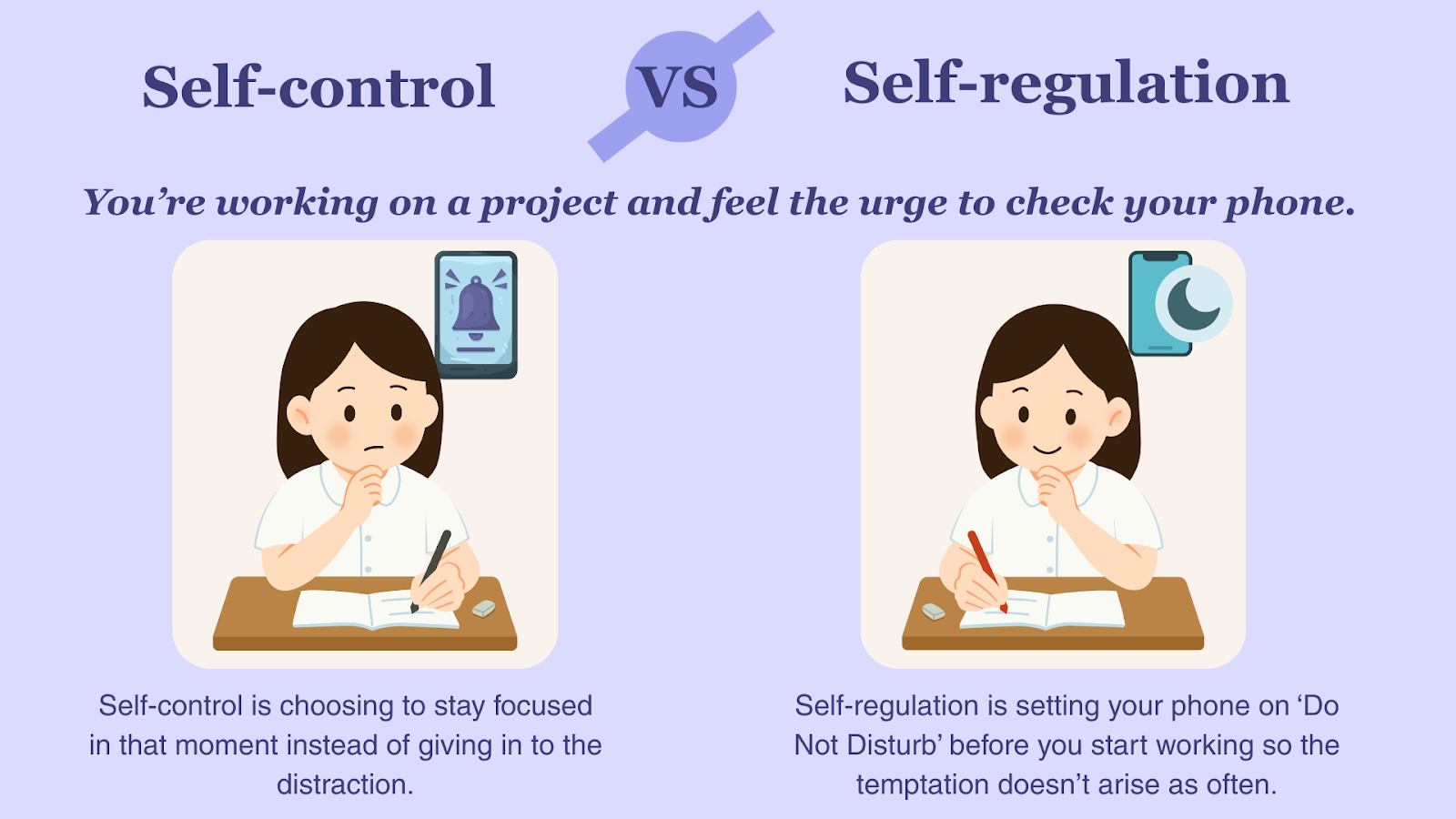Most of us have moments when we know what we should be doing, yet find ourselves doing the opposite. Maybe you sit down to study but end up scrolling TikTok. Saying something quickly in the moment and later wishing you had paused before speaking. Or maybe you want to focus at work, but your mind keeps wandering.
These moments are part of being human. But they can feel especially frustrating when they keep us from the things we care about, whether that’s doing well in school, being present for family, succeeding at work, or simply feeling more balanced and capable in daily life.
That’s where self-restraint comes in. Self-restraint is the ability to stay aligned with your goals, even when temptations and distractions arise. And the research is encouraging: it’s not fixed. With practice, it can grow stronger – like a muscle.
Before You Read: We understand that the information and strategies we share may not feel helpful for everyone. If you are in need of additional support or resources, please reach out to a professional, or connect with our team at contact@layla.care.
In this blog, we’ll cover:
Think of your goals like preparing for a trip.

Self-restraint builds on self-control, but self-control goes a little further. It involves planning ahead, reflecting on what matters to you, and making choices that support your overall well-being. Both are important parts of self-regulation and can improve with time and intention.
Everyone experiences distraction and temptation, but for some, these challenges can feel stronger during stressful times or when coping with conditions such as ADHD or bipolar disorder.
The brain systems that support planning, focus and impulse control do not work the same way for everyone. When they’re under strain, staying organized, managing impulses, or following through on goals can take extra energy and effort.
It’s important to remember: this isn’t about laziness or lack of willpower. It’s about how different brains and environments interact. Understanding that can help replace self-blame with self-compassion—and open the door to strategies that genuinely support your wellbeing.
Step 1: Strengthening Self-Regulation (Planning Ahead)
Supporting your goals often means finding ways to rely less on willpower in-the-moment. That’s your prefrontal cortex at work, creating pathways that make it easier to follow through later.
If-then planning gives your brain a script: “If I feel tempted to scroll while studying, then I’ll put my phone in another room for 20 minutes.” By making the decision in advance, you free yourself from having to negotiate with the amygdala and nucleus accumbens in the moment.
Shaping your environment works the same way. You can:
And when you do get off track, practice failing more productively. Can’t get started on a big project?
Even procrastination can move you forward if you redirect it gently.
Your brain becomes more resilient when your needs for rest, connection, and stability are met. Stress and uncertainty activate the amygdala, flooding your system with distraction and urgency, which makes planning and focus harder. Meeting those needs help calm the nervous system and strengthen the pathways that support focus, balance, and self-regulation over time.
When worries arise, try pausing to ask yourself: Is this something I can act on? If yes, take a step towards addressing it. If not, notice it and let it pass. Grounding practices such as journaling, meditation, or writing a quick list can help settle the amygdala just enough for the prefrontal cortex to come back online.
Positive emotions also play a role in self-regulation. Experience of happiness, calm, or joy strengthens the brain’s capacity to pause, reflect, and choose responses more intentionally. These moments not only feel good - they support restoring balance. Taking a walk, playing with a pet, or laughing with a friend can quiet stress circuits and help you return to your goals with more focus.
When temptation hits, the nucleus accumbens lights up, pushing you toward the instant reward. The amygdala adds urgency – “Do it now!” This is where self-control comes in: creating space for the prefrontal cortex to take the wheel.
The encouraging news? Willpower isn’t something that gets used up like a battery. Research shows it’s influenced by belief. If you see self-control as renewable, you’re more likely to persist, even after challenges. Think of times when doing something hard actually energized you: finishing a tough project, waking up without hitting snooze, or sticking to a plan even when it was tempting to quit. Those moments show how the brain can shift from depletion to momentum.
Two strategies can help in the heat of the moment:
The more we connect our actions to purpose, the easier it becomes to steady ourselves in challenging moments. Each time you pause, reframe, or step back, you’re strengthening the brain’s pathways for focus and flexibility. Self-regulation grows from these small moments of awareness, not from perfection, but from practice, patience, and self-kindness.
Building self-restraint is less about “perfect willpower” and more about understanding how your brain works and giving yourself the right supports. Sometimes that means planning ahead to minimize temptations, and other times it means pausing in the moment to reframe the experience. Progress happens in small, repeatable steps, and every time you practice, you strengthen the pathways that make future self-restraint easier.
If you require any immediate support, please reach out to a professional, or click here to explore our crisis and community resources. If you’d like to inquire about finding mental health support that’s right for you, a member of our team is happy to assist you. You can email us at contact@layla.care for any inquiries, or complete our intake form to reach out to a member of our care team.